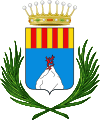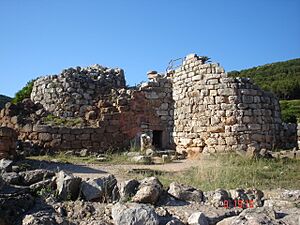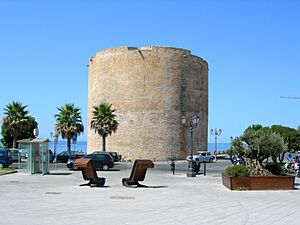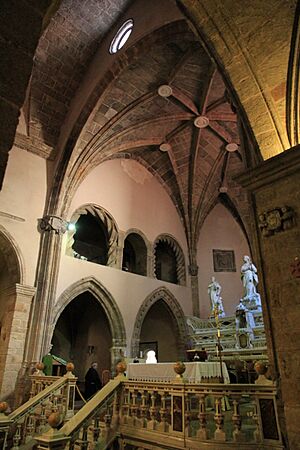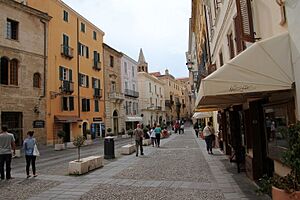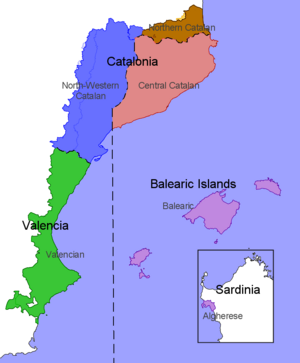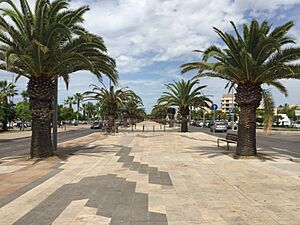Alghero facts for kids
Quick facts for kids
Alghero
|
|||
|---|---|---|---|
| Città di Alghero Ciutat de l'Alguer |
|||

16th-century Aragonese Crown city walls
|
|||
|
|||
| Country | Italy | ||
| Region | Sardinia | ||
| Province | SS | ||
| Frazioni | Fertilia, Guardia Grande, I Piani, Loretella, Maristella, Sa Segada, Santa Maria La Palma, Tramariglio, Villassunta | ||
| Area | |||
| • Total | 224.43 km2 (86.65 sq mi) | ||
| Elevation | 7 m (23 ft) | ||
| Population | |||
| • Total | 43,945 | ||
| • Density | 195.807/km2 (507.138/sq mi) | ||
| Time zone | UTC+1 (CET) | ||
| • Summer (DST) | UTC+2 (CEST) | ||
| Postal code |
07041
|
||
| Dialing code | 079 | ||
| Patron saint | St. Michael | ||
| Saint day | 29 September | ||
Alghero is a beautiful city with about 45,000 people. It is located in the northwest of Sardinia, an island in Italy. The city sits right by the Mediterranean Sea. Its name, Aleguerium, comes from an old Latin word. It means "stagnation of algae," which refers to the seaweed found in its waters.
Alghero is special because many of its people still speak a language from the Crown of Aragon. This was a powerful kingdom that ruled Sardinia a long time ago. The language, called Algherese, is a type of Catalan. It is officially recognized as a minority language in the area.
The city is also an important place for learning. It is the third largest university center on the island. It hosts part of the Università degli Studi di Sassari, focusing on Architecture and Design.
Contents
History of Alghero
The area around Alghero has been home to people for a very long time. Even before recorded history, ancient cultures lived here. The Ozieri culture was present about 6,000 years ago. You can still see their ancient burial sites at the Necropolis of Anghelu Ruju. Later, around 1,500 BC, the Nuraghe civilization built their unique stone towers here.
Around 800 BC, the Phoenicians arrived. They were skilled traders and metalworkers. The town of Sant'Imbenia, near Alghero, became a busy trading spot. People from both Phoenician and Nuragic cultures lived and worked there. They traded with the Etruscans on the Italian mainland.
Founding and Early Rule
Alghero became a strong port city by 1102. It was built by the Genoese Doria family, who were powerful rulers. They controlled Alghero for many centuries. For a short time, between 1283 and 1284, the city was ruled by Pisa.
The city grew when many Catalan people moved there. In the early 1500s, Alghero became a bishopric, which means it had its own bishop. It also gained the title of King's City. This helped the city's economy grow.
Aragonese and Spanish Rule
The Crown of Aragon took control of Alghero by force. This happened under King Pere III of Aragon (who ruled from 1336 to 1387). He encouraged many families from different parts of his kingdom to move to Alghero. These families came from places like Valencia, Majorca, and Catalonia. They were given special benefits to settle there. The original people of Alghero were moved to other places.
The new settlers spoke different types of Catalan. Over time, their language became the unique Algherese dialect spoken today. Even after the Crown of Aragon's power faded, the Catalan language stayed strong in Alghero.
After the Aragonese, the Spanish Habsburg family ruled Alghero until 1702. They continued to expand the city.
Later History
In 1720, Alghero and the rest of Sardinia became part of the House of Savoy. This family ruled from Piedmont in Italy. They started a policy to make everyone speak Italian. In 1821, a food shortage led to a rebellion, which was put down harshly. By the end of the 1800s, Alghero was no longer a military town.
During the Fascist era, some swampy areas around Alghero were drained. New towns like Fertilia and S.M. La Palma were built. In World War II (1943), Alghero was bombed, and its old center was badly damaged. The problem of malaria in the countryside was finally solved in the 1950s. Since then, Alghero has become a very popular place for tourists.
Geography and Climate
Where is Alghero?
Alghero is on the northwest coast of Sardinia. It is located along a bay that shares its name. To the north, you'll find the flat Nurra plain. To the northwest, there are interesting rocky areas like Capo Caccia and Monte Doglia. The southern part of the area has mountains and plateaus.
What is the Climate Like?
Alghero has a mild climate because it is right by the sea. The sea helps keep temperatures from getting too hot or too cold. Summers are warm, like in most Mediterranean places. Winters are also mild, and it rarely gets below freezing.
| Climate data for Capo Caccia (1991–2020) | |||||||||||||
|---|---|---|---|---|---|---|---|---|---|---|---|---|---|
| Month | Jan | Feb | Mar | Apr | May | Jun | Jul | Aug | Sep | Oct | Nov | Dec | Year |
| Mean daily maximum °C (°F) | 12.9 (55.2) |
12.9 (55.2) |
14.8 (58.6) |
17.1 (62.8) |
20.9 (69.6) |
24.8 (76.6) |
27.5 (81.5) |
28.1 (82.6) |
24.8 (76.6) |
21.8 (71.2) |
17.4 (63.3) |
14.1 (57.4) |
19.8 (67.6) |
| Daily mean °C (°F) | 11.0 (51.8) |
10.7 (51.3) |
12.3 (54.1) |
14.3 (57.7) |
17.8 (64.0) |
21.6 (70.9) |
24.3 (75.7) |
25.1 (77.2) |
22.0 (71.6) |
19.2 (66.6) |
15.2 (59.4) |
12.1 (53.8) |
17.1 (62.8) |
| Mean daily minimum °C (°F) | 9.0 (48.2) |
8.4 (47.1) |
9.8 (49.6) |
11.6 (52.9) |
14.8 (58.6) |
18.5 (65.3) |
21.2 (70.2) |
22.0 (71.6) |
19.3 (66.7) |
16.6 (61.9) |
13.0 (55.4) |
10.1 (50.2) |
14.5 (58.1) |
| Average precipitation mm (inches) | 43.4 (1.71) |
38.7 (1.52) |
31.1 (1.22) |
36.2 (1.43) |
37.0 (1.46) |
16.5 (0.65) |
4.20 (0.17) |
7.70 (0.30) |
41.0 (1.61) |
61.8 (2.43) |
82.2 (3.24) |
57.7 (2.27) |
457.5 (18.01) |
| Average precipitation days (≥ 1.0 mm) | 7.03 | 6.77 | 5.61 | 5.75 | 4.24 | 2.03 | 0.60 | 1.23 | 4.43 | 6.43 | 9.33 | 7.87 | 61.32 |
| Average relative humidity (%) | 80.45 | 78.12 | 77.43 | 77.22 | 75.51 | 73.97 | 72.18 | 71.28 | 74.50 | 76.33 | 77.55 | 79.11 | 76.14 |
| Source: NCEI | |||||||||||||
Language and Culture
A special kind of Catalan is spoken in Alghero. It was brought by the Catalans who settled there centuries ago. Over time, Spanish and then Italian became the official languages of Sardinia. However, Algherese Catalan is still important.
Recent studies show that about 24% of people in Alghero learned Algherese Catalan as their first language. About 18% speak it regularly. Since 1997, this language has been officially recognized. Laws protect its use in the city. Today, artists like Franca Masu create music in Algherese Catalan.
Many people in Alghero also speak or understand Sardinian. This is because people from nearby Sardinian-speaking villages moved to the city. Historically, Catalan was mostly spoken in the city itself. The countryside around Alghero always had Sardinian-speaking people.
The old part of Alghero looks a lot like medieval Catalan cities. Locals often call their city 'Barceloneta', which means 'little Barcelona'. This shows their strong connection to the capital of Catalonia. The food in Alghero is a mix of Catalan cuisine and Sardinian cuisine.
Main Sights to See
Alghero has a rich history, and you can see it in its many monuments and buildings. From ancient times to today, Alghero has become a popular tourist spot. People come not only for its beautiful coast but also for its well-preserved historical treasures.
Ancient Sites
You can visit several ancient sites outside the city. These include the Necropolis of Anghelu Ruju, an old burial ground. There's also Santu Pedru hill and the Roman Villa of Santa Imbenia. Many Nuraghe towers, like Palmavera, are also well-preserved and open to visitors.
City Walls and Towers
Alghero's first city walls were built in the 1200s by the Genoese. In 1354, the Catalans took over and rebuilt the defenses. Ferdinand the Catholic later added most of the walls in the 1500s to protect the city even more. Along the walls, you can find seven towers and three forts.
Some famous towers include the Torre del Portal, built in 1360. There's also the Tower dell'Esperò Reial from the 1500s.
Religious Buildings
- The Alghero Cathedral (Cattedrale di Santa Maria Immacolata di Alghero) is the main church. Building started in 1570, but it wasn't finished until 1730. The original church was in the Catalan-Gothic style. You can still see this in the chapels near the altar.
- The Church of St. Francis was built in 1360 and rebuilt later. You can see original Catalan-Gothic parts inside.
- The Church of St. Michael.
- The Madonna del Santo Rosario.
Other Interesting Places
- The Palazzo D'Albis (1500s) is a great example of Aragonese architecture. Emperor Charles V stayed there in 1541.
- Neptune's Grotto is a large, beautiful cave discovered in the 1800s.
- Palazzo Carcassona.
Alghero is also famous for its red coral. This coral is considered some of the best in the Mediterranean. It is so important that this part of the coast is called the Riviera del Corallo (Coral Riviera). The city's coat of arms and flag even show a branch of red coral!
Alghero's Territory
Villages and Hamlets
Around Alghero, there are several smaller villages and hamlets. Most have their own church and some shops.
- Fertilia is known for being a "foundation city" built during the Fascist era. It's also where the airport is located.
- Santa Maria La Palma is famous for its winery, Cantina sociale.
- Other villages include Maristella, Tramariglio, Guardia Grande, Villa Assunta, Sa Segada, I Piani, and Tanca Farrà.
Alghero's landscape is also a big draw. It has many beaches, bays, and natural parks along the coast. The Capo Caccia promontory and its lighthouse are famous landmarks.
Coast and Beaches
- Spiaggia di Poglina o della Speranza
- Cala Burantino
- San Giovanni
- Lido
- Maria Pia
- Le Bombarde
- Lazzaretto
- Mugoni
- La Stalla
- Punta Negra
- Cala Dragunara
Natural Parks
- Area naturale marina protetta Capo Caccia – Isola Piana (a protected marine area)
- Parco regionale di Porto Conte (a regional park)
Transport and Connections
Alghero is well-connected to other places. Roads lead to Sassari, the capital of its province. The main port for passengers is about 30 kilometers away. Alghero – Fertilia airport has flights to other parts of Italy and Europe.
Roads
- Strada statale 127bis Settentrionale Sarda: This road goes north to Porto Conte and east to Sassari.
- Strada statale 291 della Nurra: From Fertilia to Sassari.
- Strada provinciale 42 dei Due Mari: This road reaches the port in Porto Torres.
- Strada provinciale 105 Alghero-Bosa: A scenic road that starts in Alghero and follows the coast to Bosa.
- Strada statale 291 dir del Calich: Connects to and from the airport.
Trains
Alghero has a train station called Sant’Agostino. It's in the Pietraia neighborhood. You can take daily trains to Sassari from here.
Port
There is a port in the heart of Alghero for leisure boats and fishing. Larger passenger ferries use the port of Porto Torres, which is about 30 kilometers north. From Porto Torres, you can take ferries to Genoa, Barcelona, and Civitavecchia.
Airport
The Alghero-Fertilia "Riviera del Corallo" Airport is 10 kilometers from the city center, near Fertilia. It is the main way to connect Alghero with the rest of Italy and Europe by air. There is a bus service every hour to Fertilia and Alghero's center.
Books About Alghero
In the 1930s, the Swedish writer Amelie Posse Brazdova wrote a book called Sardinia Side Show. It tells the story of two years she spent in Alghero's old town during World War I.
Sports Events
Alghero has hosted many exciting sports events:
- Scala Piccada (motor racing)
- The Rally di Sardegna (part of the WRC motor racing)
- Gara del Miglio marino (swimming race)
- Italian Welter Weights Championship (boxing)
- Trofeo Tore Burruni (boxing)
- Regata di Sant'Elm (lateen sailing)
- Trofeo Sant Joan (sailing)
- International Women's Judo Tournament (Jūdō)
- Sardinian Open Wheelchair Tennis (wheelchair tennis)
- Volta a Catalunya 1986 edition (road cycling)
- Giro d'Italia 2007 and 2017 editions (road cycling)
- Davis Cup, Italy-Luxembourg match in 2007 (tennis)
- Rally di Sardegna, 2020 edition
Twin Towns
Alghero has special connections with these towns:
 Balaguer, Catalonia
Balaguer, Catalonia Tarragona, Catalonia
Tarragona, Catalonia Palma de Mallorca, Balearic Islands
Palma de Mallorca, Balearic Islands Encamp, Andorra
Encamp, Andorra
Notable People
- Antoni Ballero (1927–2009), a Catalan poet.
Images for kids
See also
 In Spanish: Alguer para niños
In Spanish: Alguer para niños



